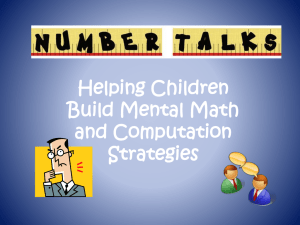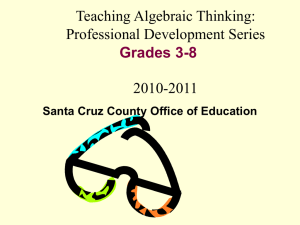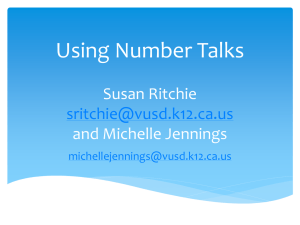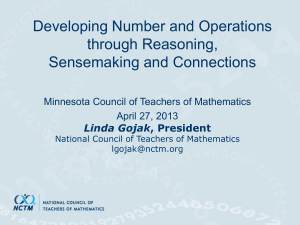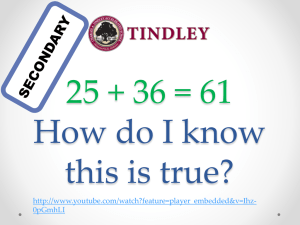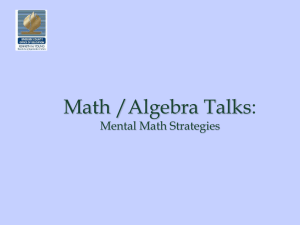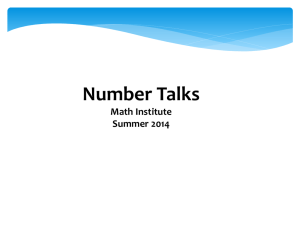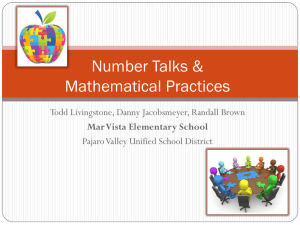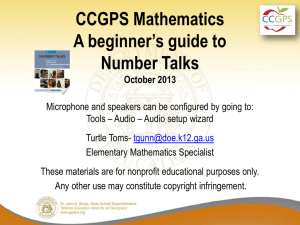Number Talks Powerpoint
advertisement
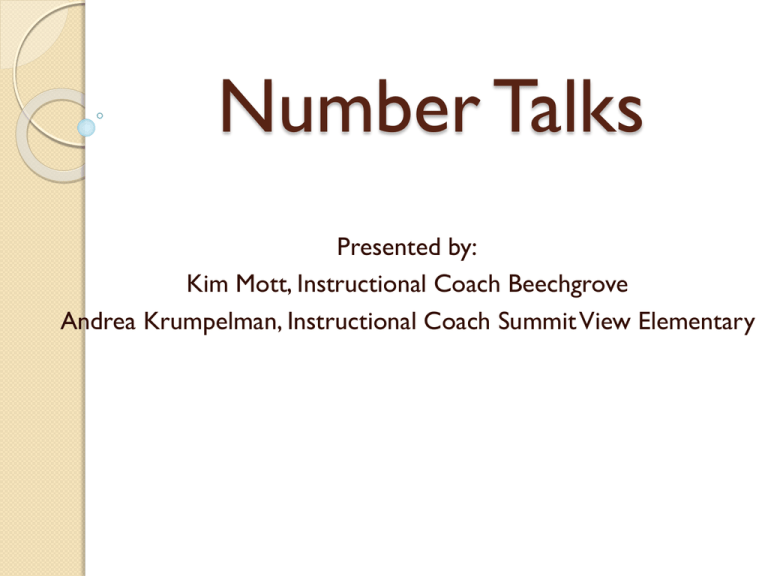
Number Talks Presented by: Kim Mott, Instructional Coach Beechgrove Andrea Krumpelman, Instructional Coach Summit View Elementary Entrance Ticket How has your instruction in math changed this year as a result of the common core standards? “How to Get Students Talking! Generating Math Talk That Supports Math Learning” Article: “Number Talks Build Numerical Reasoning” by: Sherry Parrish www.nctm.org Why Talk About Math “ Our classrooms are filled with students and adults who think of mathematics as rules and procedures to memorize without understanding the numerical relationships that provide the foundation for these rules.” What are Number Talks? Classroom conversations and discussions around purposefully crafted computation problems are at the very core of number talks. Number Talks incorporate: Accuracy: The ability to produce an accurate answer. Efficiency: The ability to choose an appropriate, expedient strategy for a specific computation problem. Flexibility: The ability to use number relationships with ease in computation. Number Talks in Action Before we watch the third grade number talk for 70-34, think about how you would mentally solve this problem. As you are viewing the video clip, consider the following: 1. 2. 3. 4. How are students using number relationships to solve the problem? How would you describe the classroom community and environment? Which strategies demonstrate accuracy, efficiency, and flexibility? How are the students’ strategies similar or different from your strategy? The Key Components of Number Talks 1. 2. 3. 4. 5. Classroom environment and community Classroom discussions The teacher’s role The role of mental math Purposeful computation problems Classroom Environment and Community Safe, risk-free environment Students comfortable and offer responses for discussion Classroom exhibits a culture of acceptance based on the common goal of learning and understanding Community of learners based on mutual respect Classroom Discussions Develop system for students to respond to questions, while allowing for think time. What did we see in the video clip? The Teacher’s Role “Since the heart of number talks is classroom conversations, it is appropriate for the teacher to move into the role of facilitator.” Teachers must change their thinking from concentrating on the final correct answer, to listening and learning about students’ natural thinking through asking open ended questions. “What answer did you get?” “How did you get your answer?” The Role of Mental Math Students need to approach problems without paper and pencil, and are encouraged to rely on what they know and understand about numbers and how they are related. Mental computation helps students strengthen their understanding of place value. Purposeful Computation Problems Careful planning BEFORE the number talk is necessary to design “just right” problems for students. This planning is important because we want to have a purposeful number talk with a common focus/specific skill in mind. Establishing Procedures and Setting Expectations: The Four Essentials The number talk is designed to be only five to fifteen minutes of focused discussion. 1. Select a designated location that allows you to maintain close proximity to your students for informal observations and interactions. 2. Provide appropriate wait time for the majority of the students to access the problem. 3. Accept, reject, and consider all answers. 4. Encourage student communication throughout the number talk. Holding Students Accountable for their Learning Ask students to use finger signals to indicate the most efficient strategy. 2. Keep records of problems posed in the corresponding student strategies. 3. Hold small-group number talks every day. 4. Create and post class strategy charts. (living document) 5. Require students to solve an exit problem using the discussed strategies. (use an index card) 6. Give a weekly computation assessment. 1. Four Goals for K-2 Number Talks 1. Developing number sense “Number sense is an awareness and understanding about what numbers are, their relationships, their magnitude, the relative effect of operating on numbers, including the use of mental mathematics and estimation.” 2. 3. 4. Developing fluency with small numbers Subitizing (immediately recognizing a collection of objects as a single unit) Making tens Classroom Link: Ten-Frames and Dot Cards Classroom Clip: Kindergarten Consider the following while viewing the clip: 1. How does the teacher build student fluency with small numbers? 2. What questions does the teacher pose to build understanding? 3. How are the tools and models used to support the goals of K-2 number talks? 4. What strategies are the students using to build meaning of the numbers? 5. What examples of subitizing, conserving number, and oneto-one correspondence do you notice? 6. What opportunities are created for the students to begin building an understanding of ten? 7. How does the teacher support student communication during the number talk? Classroom Link: Ten-Frames: 8+6 Classroom Clip 2nd grade Consider the following while viewing: 1. How does the teacher build student fluency with small numbers using ten-frames? 2. What questions does the teacher use to build understanding about decomposing and composing? 3. How are the double ten-frames used to support the goals of K-2 number talks? 4. What strategies are the students using to build meaning of the numbers? 5. What opportunities are created for the students to understand and use 10 as a unit? 6. How do the students demonstrate composing and decomposing numbers? Five Goals for Number Talks 3-5 1. 2. 3. 4. 5. Number sense Place value Fluency Properties Connecting mathematical ideas Classroom Link: Subtraction: 1000-674 Classroom Clip 5th Grade As you watch the video, consider the following: 1. What evidence in the video supports student understanding of place value? 2. How do the students’ strategies exhibit number sense? 3. How does fluency with smaller numbers connect to the students’ strategies? 4. Which strategies were most accessible to you? More challenging to follow? 5. How are accuracy, flexibility, and efficiency interwoven in the students’ strategies? Bringing It All Together: Number Talks from the Schoolwide Perspective “We have just taken a journey of number talks from kindergarten through the fifth grade by viewing video clips and group discussions. While teacher personalities and environments may change as students transition from grade level to grade level, essential number talk content and characteristics remain consistent from year to year. This consistency in teaching mathematically big ideas, instruction rooted in asking rather than telling, developing a safe learning community, and an unwavering quest for making sense are essential in building mathematically powerful students. The consistency from grade level to grade level does not occur by coincidence; it is purposefully orchestrated by the school learning community.” Looking at Mathematics through a Common Core Lens Our goal as educators is to help students to become confident and competent in mathematics. We strive to create a classroom environment that encourages students to think critically about math in a variety of situations. As students explain their thinking to others, they self-correct and clarify their ideas leading to a deeper understanding of underlying mathematical concepts. Accuracy and the development of efficient problem-solving strategies are essential to student’s learning. The ability to solve problems many different ways and to understand the connections between mathematical ideas is equally important. As children learn to question, reconsider and justify solutions they become more confident in their own abilities as mathematicians. Exit Slip: Taking a Look at your Own Practice What changes might you make in your math instruction based on the information you learned in today’s session on Number Talks? Things to think about: - Learning community in your classroom - Your role as the teacher - Questioning techniques - Use of models and tools to support student thinking - Addressing student mistakes
